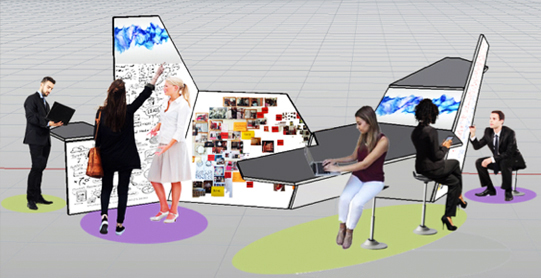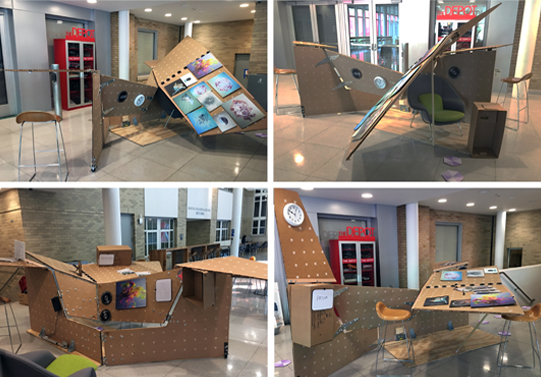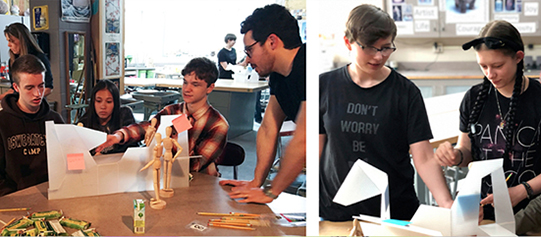--------------------------------------------
i n v e s t i g a t o r s :
Keith Evan Green (PI)
Design & Mech. Eng., Cornell
Gilly Leshed
Information Science, Cornell
Trevor Pinch
Science & Tech Studies, Cornell
Jon McKenzie
English, Cornell
--------------------------------------------
a d v i s o r s :
Gretchen Rymarchyk
Rural Schools Association of NYS
Teresa Vadakin
Tompkins County Public Library
Ben Sandberg
History Center in Tompkins County
Julia Taylor
History Center in Tompkins County
Elizabeth Rechtin
Dryden Central School District
Paul Fleming
Center for Humanities, Cornell
--------------------------------------------
s t u d e n t t e a m :
Carlos Araujo de Aguiar
PhD Design Student., Cornell
Alex Bernard
M.Eng, Mech E., Cornell
Kevin Guo
M.Eng, Mech E., Cornell
Yeolim Jo
M.Eng, Mech E., Cornell
Boya Zhang
BS, MechE and Design, Cornell
Cayla Hamann
BS, Info Sci, Cornell
Genna Haddad
BS, Info Sci, Cornell
--------------------------------------------
p a r t n e r s :
• History Center in Tompkins County
• Tompkins County Public Library
• Dryden Central School District
• Rural Schools Association of NYS
• Society for the Humanities
|
 |

communIT visualization of the kinds of collaborative activity we envision for it.
communIT a cyber-physical environment in underused public spaces, cultivating understanding and action within and across diverse local groups.
 communIT: prototype--2 in our lab. communIT: prototype--2 in our lab.
o v e r v i e w :
Despite the promise of social media to bring the world closer together, large segments of local communities, globally, remain misunderstood by or invisible to mainstream society. This problem is attributed, in large part, to digital media’s ascendancy over physical, public space as the locus for civic discourse – the loss of informal and structured encounters between members of communities there. We have been developing a novel cyber-physical platform, communIT, for community building across diverse local community groups. Deployed in underused public spaces, communIT is an origami-like, folding, robotic surface of billboard scale, with embedded peripherals, that changes form in response to group needs for group co-creation and sharing of media. By collaboratively making and sharing media with communIT, local groups can tell stories, share experiences and aspirations, and advocate within the larger community. Such civic discourse promises the potential to transform personal identity and self-representation, community awareness and responsibility, and wider social relationships with policy-makers.
We have already developed:
• a first and a second
full-scale prototype grounded in Architectural Robotics, Performance Studies, and Science and Technology Studies.
•
a digital prototype characterized in a MATLAB script that models the device’s internal forces and visualizes communIT in any physical configuration. This initial effort informed our fabrication of an early, functioning, full-scale, physical prototype. The design and kinematics efforts were reported at IEEE CASE 2018.
• user studies involving university students and, subsequently, high schools from Dryden High School (a targeted group in our research). These user studies informed our first and then our second full-scale prototypes.
The team is devoting the next years to learning from local groups how communIT best supports their needs as we refine a higher-fidelity prototype and develop a low-cost prototype for wide deployment in low-resource communities across rural and urban Upstate NY. Questions for the local groups include How does communIT change the way your group collaborates and expresses itself? Does communIT make your group and its practices and values more visible within the larger population? For members of the larger community exposed to communIT, Do their attitudes about a group sharing with communIT change following such exposure? and Can communIT improve community awareness and civic discourse? For the research team, Do collaborative research tools embedded in common places contribute to design as a democratic process? Key social science dimensions from the SCC call are: innovations in community behavioral or social change experiments, and studies of collaboration processes within and across communities; key technological dimensions are innovations in integrating materials and systems, and design of interfaces and control.
 communIT: artist rendering of envisioned use outdoors in public spaces. communIT: artist rendering of envisioned use outdoors in public spaces.
i n t e l l e c t u a l m e r i t :
1) A space-making robot. We develop, with community groups, a novel, 2D robot surface that actively shapes physical space and human activity - a contribution to robotics and interactive systems designed for the public. 2) Understanding of how such a technology shapes and is shaped by numerous, diverse community groups, informed by three disciplinary perspectives. 3) A community-building platform. We expect that communIT will (a) prove a compelling platform for lending a voice to local community groups; (b) afford these groups novel discovery of their identity, processes, and roles they play in the larger community; and (c) positively impact acceptance of these groups by the larger community. 4) An exemplary record of community groups engaging with a cyber-physical artifact.
 communIT: prototype-1. communIT: prototype-1.
 communIT: prototype-1 in four different physical configurations as defined by users (university students) for supporting routines they envision in this space with this artifact. communIT: prototype-1 in four different physical configurations as defined by users (university students) for supporting routines they envision in this space with this artifact.
 communIT: high s
chool students helping us envision prototype-2. communIT: high s
chool students helping us envision prototype-2.
p r a c t i c a l l y :
communIT is a series of hinged, responsive panels with embedded lighting, audio, and displays that transform according to needs. While McLuhan characterized information as non-spatial, communIT claims the cyber-physical - a technologically-rich, reconfigurable, spatial form. The objective is to embed technology into the built environment to, in W. Mitchell's words, create fresh urban relationships, processes, and patterns.
publications
de Aguiar C.H.A., Green K.E. 2020. CommunIT Building. Book Chapter. In McCrickard D.S., Jones M., Stelter T.L. (eds) HCI Outdoors: Theory, Design, Methods and Applications. Human–Computer Interaction Series. Springer. https://doi.org/10.1007/978-3-030-45289-6_12
De Aguiar, C., Leshed, G., Pinch, T., and Green, K. E. 2022. Evaluation of communIT, a Large-Scale, Cyber-physical Artifact Supporting Diverse Subgroups Building Community. Journal of Smart Cities and Society (2022), IOS Press, pp. 287-296. DOI: 10.3233/SCS-220007
Carlos Henrique Araujo de Aguiar, Keith Green, Trevor Pinch, Gilly Leshed, Kevin Guo, and Yeolim Jo. 2021. Designing and Building communIT. In Media Architecture Biennale 20 (MAB20). Association for Computing Machinery, New York, NY, USA, 1–11. https://doi.org/10.1145/3469410.3469411.
Our early paper for IEEE CASE 2018 on models (kinematics, internal forces):
Bernard, A., de Aguiar, C. Green, K. E. 2018. Model for a Rigid, 3D Mechanism Inspired by Pop-Up Origami, and its Application to a Re-configurable, Physical Environment. In Proceedings of IEEE CASE 2018: the 14th Conference on Automation Science and Engineering, August 20-24, Munich, Germany.
Our early paper for (ACM) DIS 2018 introducing communIT:
Aguiar, C. and Green, K. E. 2018. transFORM - A Cyber-Physical Environment Increasing Social Interaction and Place Attachment in Underused, Public Spaces. In Proceedings of the 2018 ACM Conference Companion Publication on Designing Interactive Systems (DIS '18 Companion). ACM, New York, NY, USA, 231-236. DOI: https://doi.org/10.1145/3197391.3205441
Technical report on the transFORM digtal model:
Bernard, Alex. Masters of Engineering report. Cornell MAE McManus Design Prize.

communIT: artist rendering of outdoor installation.
|
 |











 communIT: artist rendering of envisioned use outdoors in public spaces.
communIT: artist rendering of envisioned use outdoors in public spaces. communIT: prototype-1.
communIT: prototype-1. communIT: prototype-1 in four different physical configurations as defined by users (university students) for supporting routines they envision in this space with this artifact.
communIT: prototype-1 in four different physical configurations as defined by users (university students) for supporting routines they envision in this space with this artifact.
